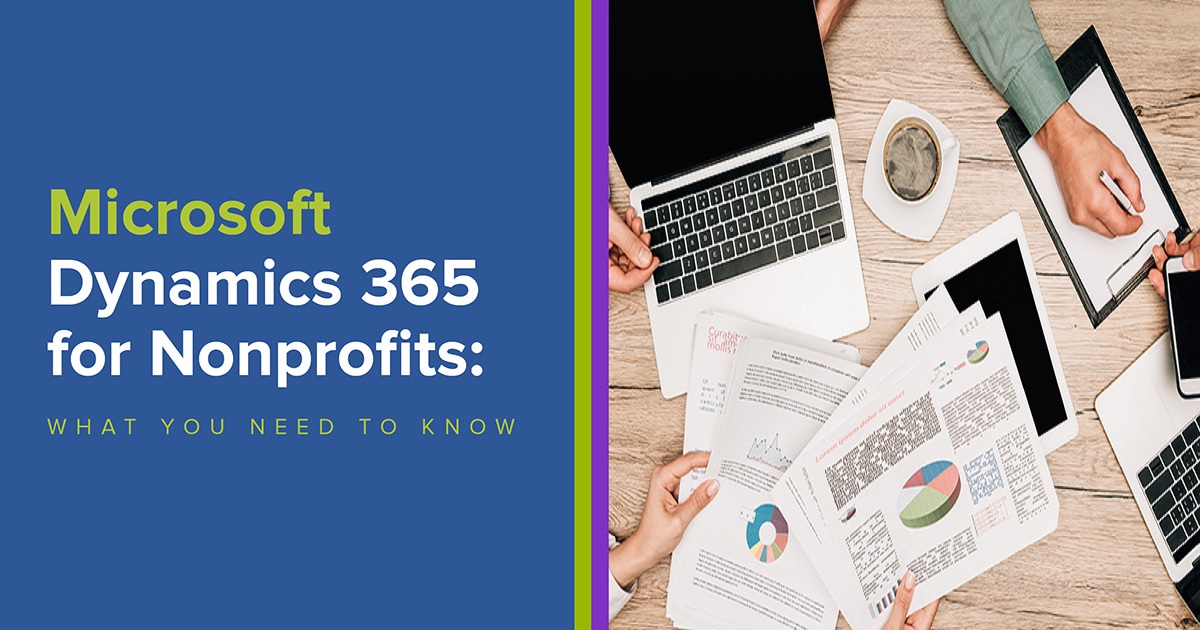
Nonprofit Management
Article | July 20, 2022
Just like that, we went from talking about the rising trends in fundraising for 2020 to how nonprofits can sustain operations during the COVID-19 pandemic. Needless to say, it was quite the pivot in conversation. The COVID-19 pandemic has had major implications for nonprofit organizations. Unfortunately, it seems as though the uncertain landscape created by the COVID-19 pandemic will be sticking around for the foreseeable future. With that in mind, it’s time for your organization to consider how it can be agile and thrive through uncertainty.
Read More

Nonprofit Management
Article | July 14, 2022
Microsoft Dynamics 365 for Nonprofits is a name you're likely to hear very frequently in the nonprofit tech space over the next several years. As Microsoft's own cloud-based CRM platform, Dynamics for Nonprofits offers a new technology option for organizations of all sizes. If you're already using a range of Microsoft products (or have heard of Microsoft's generous Tech for Social Impact initiative) but haven't yet heard of Dynamics, you're definitely going to want to have it on your radar.
Read More

Nonprofit Management
Article | July 15, 2022
Volunteers are the lifeblood of any nonprofit. Your services, fundraising campaigns, and even day-to-day operations of your nonprofit can depend on volunteers.
An estimated 30 percent of Americans or 77.9 million people reported they volunteered for an organization or association.”
AmeriCorps published survey
So, if people want to volunteer, the key to garner willing volunteers is to:
Communicate your needs
Share your “why”
Make it easy
While all nonprofits know they need volunteers, investing time and energy into building a program can naturally fall by the wayside. As you look to recruit and retain volunteers, a best practice is to put a strategic volunteer program in place.
You may be asking, “What’s the benefit to me, the nonprofit?” Let’s dive into it!
First, let’s start with the basics — what are the top reasons to invest in a volunteer program? We’ve got you covered. A dynamic volunteer program:
Creates ambassadors for your mission. Volunteers spread the word in your community and increase your community engagement. They can advocate for you with their friends, family, and local and state legislatures. Provide your volunteers with messaging so they can share their “why” on social media and by word of mouth. One pro tip shared by Points of Light is to provide a digital badge to add to your volunteer leaders’ email signatures.
Develops new funding sources. The line between a volunteer and donor should be fluid, not separate. A 2014 study by Fidelity Charitable found that 83% of volunteers report supporting the same nonprofits with their donations. Don’t silo your volunteers and your donors!
Reduces your operating costs. According to the Independent Sector, the value of a volunteer hour was estimated at $28.54 in 2020. Since payroll is often the largest expense for a nonprofit, volunteers provide essential support to your cause with minimal costs to you.
Increases the quantity and quality of your programs and services. It’s a win-win situation for professional development and your lengthy project list! That list will be met by an eager, talented volunteer, and your volunteer will improve their professional skills at the same time.
Maximizes your limited staff resources. We’re sure there’s been a few items on your wish list that you’d love to check off if you had more resources, like being open on holidays or offering more services to your community. Volunteers can fill in those gaps! Maybe they are looking for ways to give back over a holiday, or they may have the connections to develop a new service opportunity for you.
Increases your diversity and brings in new ideas. Although your nonprofit may always strive to diversify or get out of the “we’ve always done it this way” rut, you may not meet the potential of those goals with your staff. Volunteers can provide unique perspectives, different experiences, and even that spark of excitement that comes with a new idea.
Minimizes volunteer turnover.Just like staff onboarding, volunteer onboarding takes time and money. If you recruit and onboard well with easy-to-access opportunity matching, training, and tracking mechanisms in place, your volunteers will be well on their way to a successful experience. Build on that by learning more about your volunteers’ interests and skills, and they will feel seen and appreciated. An upfront investment will pay off in years of dedicated service.
Are you convinced? If so, it’s time to take the next step of how to start putting a volunteer program into place. Then you can scale your volunteering as your nonprofit grows!
Here are our 5 fundraiser-approved steps to developing a bullet-proof volunteer program.
Step 1: Quantify your current volunteer impact.
Gather data on number of volunteers, hours and skills contributed.
Measure the return on investment (ROI) including your program cost and total estimated volunteer value (# of volunteer hours x est. volunteer wage per hour). You can even take it a step further and consider the monetary savings to the community when volunteers provide the service or in-kind donation versus a private provider (e.g. number of children tutored or trees planted).
Step 2: Educate your staff and board on the benefits of volunteering.
Share your ROI and other data with your executive team and board and garner to get them on board. Recruiting, onboarding, engaging, and retaining your volunteer base will be much smoother when you have their support.
Step 3: Purchase or build a volunteer management software system.
Track volunteer hours, record your volunteers’ information, and create reports. Your software/tracking system should include a personalized volunteer dashboard where they can track their hours and volunteer services provided, demonstrating to them their impact in real-time.
Step 4: Develop a plan for recruitment, training, and growth opportunities for your volunteers.
Share the plan with your current volunteer leaders and solicit their feedback before rolling out to the community.
Step 5: Make the case for even more investment in your program next year.
Give insight into how your efforts to recruit, engage, and retain volunteers positively impact your mission and your bottom line.
Read More
.jpg)
Nonprofit Management
Article | July 12, 2022
It is crucial to keep a keen eye on what the significant figures imply for NGO’s and how they affect their operations. Learn more in detail in the 5 key lessons!
It's alluring to concentrate just on the significant figures that affect the non-profit industry as a whole. However, it's equally crucial to concentrate on what those significant figures imply for certain NGOs and how they may affect your day-to-day operations. The report can be used to learn the following five key lessons.
Lesson One: Small-Dollar Donors Are Being Left Behind
Around 84.1% of contributors give less than $500 yearly to the organisations they support, and just 19% of new donors are retained over time, according to the most recent Fundraising Effectiveness Project data. This indicates that the great majority of small-dollar donors are leaving non-profit organizations.
Lesson Two: There are Winners and Losers by Mission Type
Donors change the emphasis they give to certain missions every year. Donors' giving priorities clearly reflect the legacy of COVID-19 as well as the enduring influence of racial and social justice movements.
The number of non-profits with missions in the arts, culture, or healthcare increased significantly in 2020. Non-profits with an emphasis on foreign affairs, human services, and education, on the other hand, had slow growth or reductions in 2021.
Lesson Three: Corporate Giving is a Distraction
It will become more crucial to engage with people instead of concentrating on corporate ties as businesses modify their philanthropic alliances and employees try to support their preferred causes outside of their workplace's giving program.
Lesson Four: It’s Time to Modernize Bequest Giving
A warning sign that NGOs are not investing in highlighting the opportunities available with legacy gifts is the decline in bequests during 2021. Although any donor can establish a contribution through their estate to a non-profit they are passionate about, there is a frequent misconception that bequests must be customized for significant donors.
Lesson Five: Retention and Acquisition Benchmarks Are Critical
For its key revenue figures, the Giving USA report heavily depends on IRS 990 information. When examining giving trends throughout the sector, that data is helpful, but it is less helpful when attempting to comprehend the behavior of all donors.
It is reassuring to see that when discussing contributors' ongoing support of NGOs, the Fundraising Effectiveness Project's data on acquisition and retention of individual donors was recognised as the primary source. It's crucial to comprehend donor behaviour, and you can achieve this by comparing the donor behaviour of your own organization to benchmarks from the ‘Fundraising Effectiveness Project.’
Read More